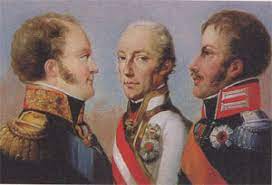On September 26th, 1815, Russia, Prussia and Austria all collaborated on and formalized an alliance to reinstall the divine right of kings and unify Christianity across these three major world powers. While many diplomats and other public servants ridiculed the alliance as being “apocalyptic” and “nonsense,” it was taken seriously enough by leaders to have been codified and implemented for some number of years. The Alliance dissolved by the 1880s because of major geopolitical disputes between Russia and Austria.
Background
The Holy Alliance was created after Napoleon’s final defeat. It was prompted by Tzar Alexander I of Russia to oppressively restrain liberalism and secularism in the wake of the brutal French Revolutionary and Napoleonic Wars. The alliance was written by one of Greece’s most distinguished statesmen, Ioannis Kappodistrias and Tzar Alexander. To some degree, this is rather ironic, as Kapodistrias was considered to be the father of modern Greece, a historical and modern bastion of liberalism and democratic ideals. Yet it must have been that all public officials played a role that yielded to the power of sovereigns of the time.
The Alliance
The Tsar’s ostensible undue influence over the Alliance prompted criticism that it was too “mystical” and enshrouded with amorphous beliefs and concepts that weren’t readily interpretable for geo- and sociopolitical cohesion. The other monarchies found it disconcerting, and, at their behest, a new document was signed that was more pragmatic.
The Holy Alliance was first kept as a secret, then heavily mistrusted by those who subscribed to liberalism as an ideology. The United Kingdom under George VI was quick to reject it, as did France. Yet on the coattails of wars inspired by revolutionary ideology, its express purpose was to suppress these instincts and ideas and forcefully impose monarchic structure onto countries that had seen this prior turmoil. The Alliance was seen as defunct by 1825, the year Alexander died.

